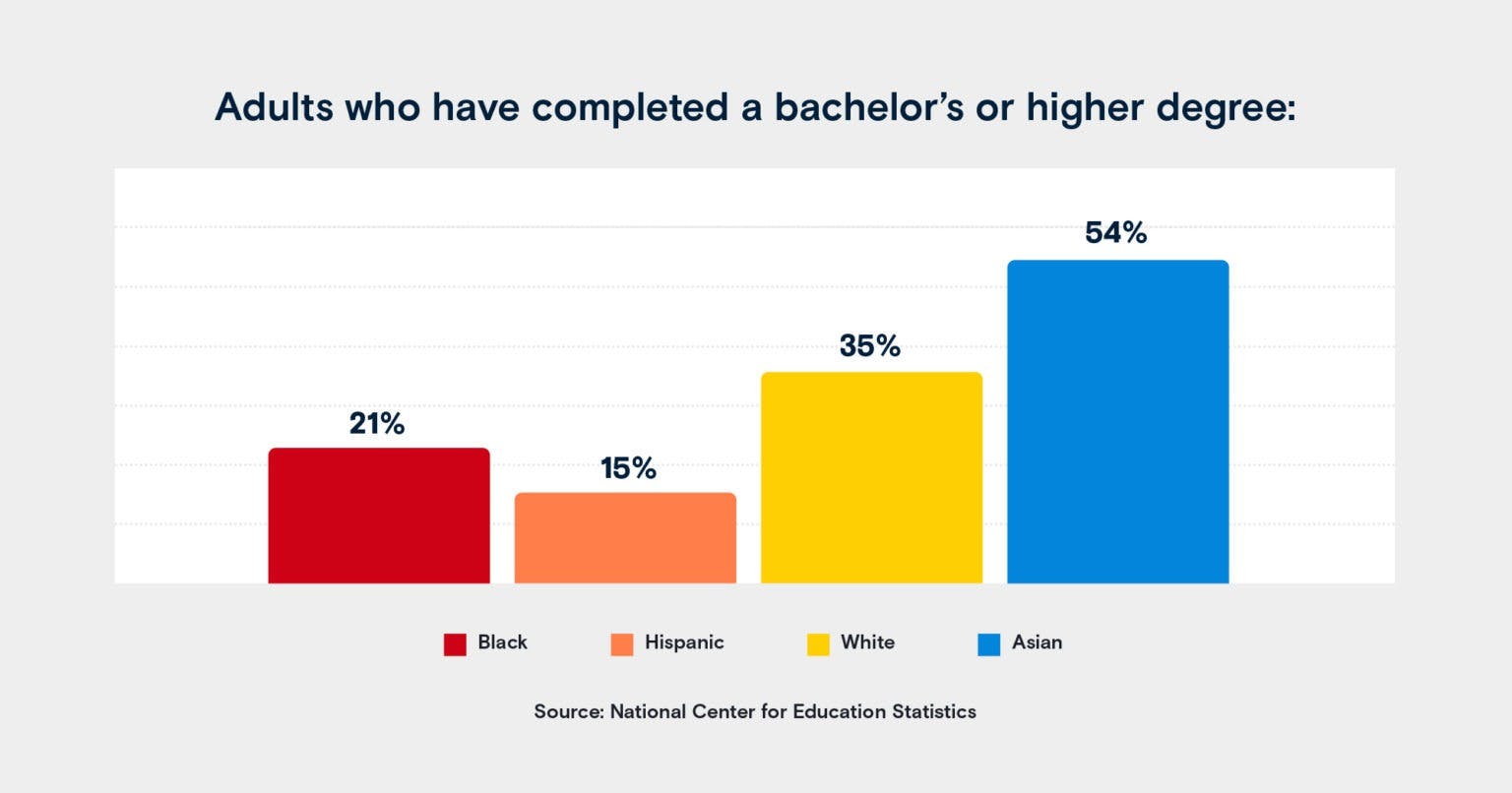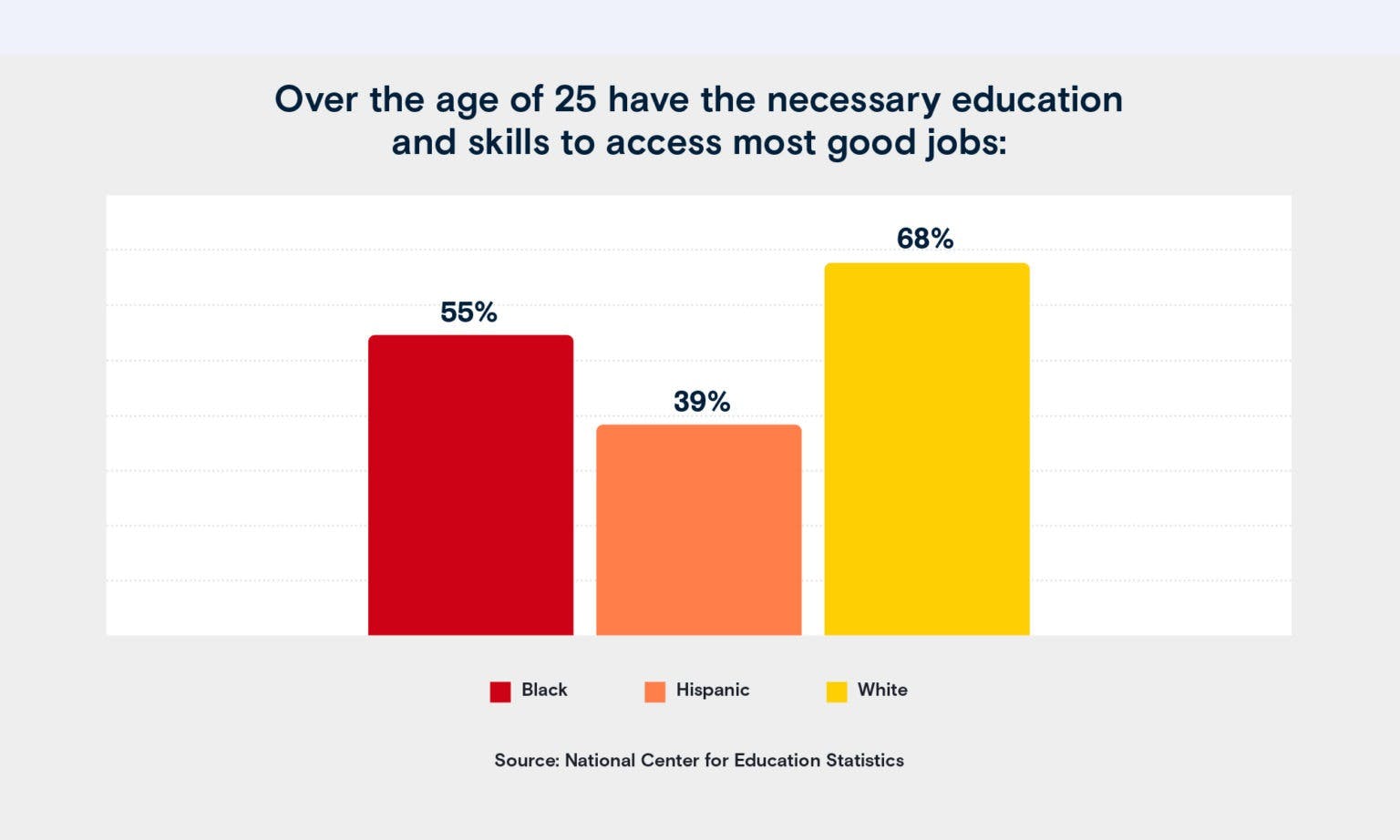Despite DEI investment falling to 27% in 2023 (down 33% from the previous year), the question of how to advance diversity, equity and inclusion in the workplace continues to be a pressing question for businesses. To help inform your efforts, here's a round-up of the top diversity in the workplace statistics to be aware of this year.
Diversity in the workplace statistics related to education
- 92% of business leaders agree a strategic workforce education program should help an organization achieve its diversity and inclusion goals. (InStride)
- Individuals with bachelor’s degrees will earn $400,000 more in their lifetimes than those with only high school diplomas. (College Board)
- Black and most other minority students are less likely to graduate with a degree than white students. 54% of Asian Americans, 35% of white Americans, 15% of Hispanic Americans, and 21% of Black Americans have completed a bachelor’s or higher degree. (National Center for Education Statistics)

- COVID-19 has exacerbated the already uneven work equity gaps. Women’s jobs are 1.8 times more vulnerable to this crisis than men’s jobs. Women make up 39% of global employment but account for 54% of overall job losses. (McKinsey)
- 69% of executives rate diversity and inclusion as an important issue. (Glassdoor)
- 44% of Black and 61% of Hispanic individuals experienced job and wage loss throughout the pandemic. (Strada)
- Black and Hispanic Americans are more likely than white Americans to enroll in education and training programs in the coming months across learning providers. (Strada)
- When over the age of 25, 68% of white Americans have the necessary education and skills to access most good jobs compared to only 39% of Hispanic Americans and 55% of Black Americans. (National Center for Education Statistics)

Diversity in the workplace statistics related to company performance
- Corporations identified as more diverse and inclusive are 35% more likely to outperform their competitors. (McKinsey)
- Diverse companies are 70% more likely to capture new markets. (HBR)
- Diverse teams are 87% better at making decisions. (People Management)
- Diverse management teams lead to 19% higher revenue. (BCG)
Gender diversity in the workplace statistics
- 6.6% of all Fortune 500 companies have women as their CEOs. (Fortune)
- Companies employing an equal number of men and women manage to produce up to 41% higher revenue. (Clear Company)
- The GDP could increase 26% by equally diversifying the workforce. (McKinsey)
- Gender-diverse companies are 15% more likely to notice higher financial returns. (McKinsey)
- 40% of people believe there is a double standard against women. (Clear Company)
- Only 23% of C-Suites are made up of women. (Women in the Workplace)
Importance of diversity in the workplace for job seekers statistics
- Around 63% of employees across all generations said they prioritize DEI programs when it comes to choosing which company to work for, while 73% of Gen Z and 68% of Millennial respondents said the same. (EY)
- 2 out of 3 job candidates seek companies that have diverse workforces. (Glassdoor)
- 74% of millennial employees believe their organization is more innovative when it has a culture of inclusion, and 47% actively look for diversity and inclusion when sizing up potential employers. (Deloitte)
Workplace inclusivity statistics
- 78% of employees who responded to a Harvard Business Review study said they work at organizations that lack diversity in leadership positions. (HBR)
- 45% of American workers experienced discrimination and/or harassment in the past year. (Gallup)
- Inclusive companies are 1.7 times more likely to be innovative. (Josh Bersin)
- Inclusive companies get 2.3 times more cash flow per employee. (Josh Bersin)
- Millennials are 83% more likely to be engaged at work at inclusive companies. (Deloitte)
By providing equal access to education, companies have the opportunity to promote diversity and inclusion, which is a win-win-win for organizations, individuals and society. Benefits from these initiatives include more sales revenue and innovation, increased social mobility and employee engagement, as well as higher profits.
Discover more workplace DEI resources: Explore this infographic to learn how organizations are uplifting diverse talent to fuel representation at the leadership level.


